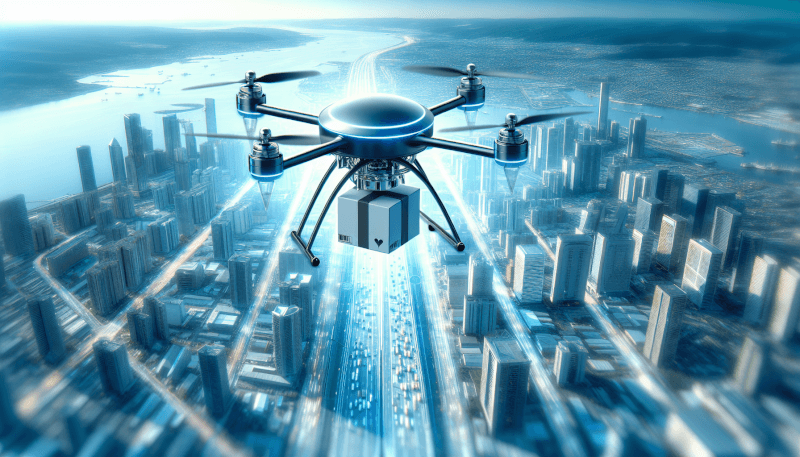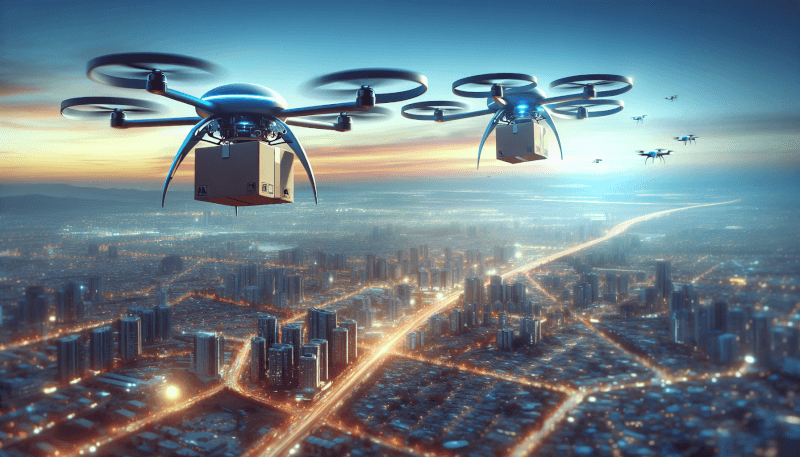Imagine a future where your packages are delivered straight to your doorstep by flying machines. Sounds like something out of a science fiction movie, right? Well, believe it or not, this futuristic vision is becoming a reality with the rise of delivery drones. These small unmanned aircraft are revolutionizing the way goods are transported, promising faster and more efficient delivery services. In this article, we will explore how delivery drones work, the challenges they face, and what exciting developments lie ahead in this rapidly evolving industry.

1. Overview of Delivery Drones
1.1 Definition and Purpose
Delivery drones, also known as unmanned aerial vehicles (UAVs), are autonomous or remote-controlled devices designed to carry and deliver packages to specified locations. These drones are equipped with advanced technologies and navigation systems that allow them to safely transport goods without the need for human intervention. The primary purpose of delivery drones is to revolutionize the logistics and transportation industry by providing faster, more efficient, and cost-effective delivery solutions.
1.2 Advantages of Delivery Drones
There are several advantages that make delivery drones an appealing option for the future of package transportation. Firstly, they offer significant time savings, as drones can deliver packages within a matter of minutes or hours instead of days. This is particularly beneficial for time-sensitive deliveries, such as medical supplies or emergency situations.
Secondly, delivery drones have the potential to reduce transportation costs. With drones, companies can avoid expenses related to fuel, maintenance, and labor associated with traditional delivery methods. This cost-effective solution may also result in lower prices for consumers.
Moreover, delivery drones have the ability to reach remote or inaccessible areas, such as rural locations or disaster-stricken regions, where conventional delivery services may face challenges. This opens up opportunities for delivering essential items in a timely manner, even under challenging circumstances.
1.3 Challenges Faced by Delivery Drones
Despite their numerous advantages, delivery drones also face various challenges that need to be addressed for widespread adoption. One of the main challenges is related to safety and security issues. Ensuring the safe operation of drones, preventing collisions, and safeguarding against potential interference pose significant hurdles.
Another challenge is the limited payload capacity of delivery drones. While they are capable of carrying small packages and goods, their capacity may not be sufficient for larger or bulkier items. Additionally, factors such as adverse weather conditions, airspace regulations, and public acceptance may further hinder the widespread use of delivery drones.
1.4 Current Applications of Delivery Drones
Currently, delivery drones are being utilized in a range of industries for various purposes. One prominent example is the retail and e-commerce sector, where drones are used to deliver products directly to customers’ homes or designated collection points. This allows for quicker delivery times and enhanced customer satisfaction.
Another significant application of delivery drones is in the medical and pharmaceutical field. Drones can transport medical supplies, vaccines, and critical equipment to remote areas or locations affected by natural disasters, improving access to healthcare services in underserved regions.
Delivery drones have also proven to be valuable in disaster relief and emergency services. They can deliver essential supplies, such as food, water, and medicines, to areas affected by natural disasters or humanitarian crises. This rapid response capability can save lives and provide immediate assistance to those in need.
Furthermore, the food and restaurant industry has started experimenting with delivery drones. Some establishments are using drones to deliver meals and snacks to customers, enhancing the overall dining experience and reducing delivery time.
2. How Do Delivery Drones Work?
2.1 Types of Delivery Drones
There are different types of delivery drones available, each with its own set of characteristics and functionalities. One common type is the quadcopter, which has four rotors and is well-suited for shorter distance deliveries. Quadcopters offer stability, maneuverability, and the ability to hover in place, making them ideal for navigating through urban environments.
Another type is the fixed-wing drone, which resembles a miniature airplane. These drones are more suitable for longer distance deliveries, as they can cover larger areas and have a longer flight time. Fixed-wing drones have the advantage of being more energy-efficient, allowing them to carry heavier payloads over extended distances.
2.2 Navigation and Control Systems
Delivery drones rely on advanced navigation and control systems to ensure safe and accurate delivery. GPS (Global Positioning System) plays a crucial role in guiding drones to their destination. Real-time GPS data allows drones to calculate the most efficient flight path, avoid obstacles, and make adjustments during flight.
Alongside GPS, drones also utilize onboard sensors, such as accelerometers, gyroscopes, and altimeters. These sensors constantly monitor the drone’s position, altitude, speed, and orientation, providing valuable data for flight control and stability.
Additionally, drones may be equipped with advanced imaging technologies, such as computer vision or LiDAR (Light Detection and Ranging), to enhance their perception of the environment. These technologies enable drones to detect obstacles, recognize landing zones, and safely navigate complex scenarios.
2.3 Payload Capacity and Delivery Mechanisms
The payload capacity of delivery drones determines the size and weight of packages that can be transported. While smaller drones may have a limited payload capacity, larger and more powerful drones can carry heavier loads.
Delivery mechanisms vary depending on the design and purpose of the drone. Some drones feature a single compartment where packages are securely stored during flight. Others may have multiple compartments or modular designs, allowing for efficient loading and unloading of multiple packages.
In terms of the actual delivery process, drones employ various mechanisms to release packages. This can involve the use of mechanical arms, parachutes, or even landing directly at the delivery location. The choice of delivery mechanism depends on factors such as the type and fragility of the package, as well as the desired level of precision.
3. Drone Delivery Process
3.1 Order Placement and Confirmation
The drone delivery process begins with the customer placing an order through an online platform or mobile application. Once the order is received, it undergoes confirmation and verification processes to ensure accuracy and availability of the requested items.
During this stage, the customer may receive notifications confirming the order details and estimated delivery time. This allows for transparency and eliminates any uncertainty regarding the delivery process.
3.2 Package Preparation and Loading
After the order is confirmed, the package is prepared for delivery. This involves securely packaging the items, ensuring they are protected during transit. The package may also be tagged or labeled with a unique identifier to facilitate tracking and monitoring.
Once the package is ready, it is loaded onto the drone. Special compartments or secure attachment mechanisms ensure that the package remains stable and undisturbed during flight.
3.3 Flight Planning and Routing
Before takeoff, the delivery drone undergoes flight planning and routing processes. This includes calculating the most optimal flight path based on factors such as distance, weather conditions, airspace restrictions, and delivery priorities.
During this stage, the drone’s navigation and control systems determine the appropriate altitude, speed, and direction for the flight. The drone also considers real-time data, such as air traffic information and weather updates, to ensure safe and efficient navigation.
3.4 Takeoff and Flight
Once all pre-flight checks are complete, the delivery drone takes off from a designated launching pad or station. It ascends to the programmed altitude and follows the predetermined flight path towards the delivery destination.
Throughout the flight, the drone continuously communicates with the ground control center and updates its position, speed, and flight status. This allows for real-time monitoring and intervention if necessary.
3.5 Arrival and Delivery
Upon reaching the delivery destination, the drone begins the descent and approaches the designated landing zone. Depending on the delivery mechanism, the drone may hover above the landing zone, lower the package with a mechanical arm, or release it using a designated release mechanism.
Once the package is securely delivered, the drone confirms the successful completion of the delivery and initiates its return journey to the base station or a predetermined location. The customer may receive a notification or confirmation of the delivery to provide a seamless and reliable delivery experience.
4. Advancements in Delivery Drone Technology
4.1 Increased Range and Flight Time
Advancements in delivery drone technology have led to significant improvements in their range and flight time capabilities. Cutting-edge battery technologies allow for longer flight durations, enabling drones to cover greater distances and deliver packages more efficiently.
This increased range and flight time have opened new possibilities for drone delivery in rural areas, remote locations, and sprawling urban environments. Delivery drones can now reach customers who were previously inaccessible using conventional delivery methods, expanding the reach of businesses and improving accessibility for consumers.
4.2 Enhanced Safety Features
Safety is a paramount concern when it comes to delivery drone operations. To address this, drone manufacturers and developers have integrated enhanced safety features into their designs. These features include collision avoidance systems, geofencing capabilities, and robust fail-safe mechanisms.
Collision avoidance systems utilize sensors and cameras to detect obstacles and automatically adjust the drone’s flight path to avoid collisions. Geofencing technology creates virtual boundaries that prevent drones from flying into restricted or unauthorized areas, ensuring compliance with airspace regulations.
Furthermore, fail-safe mechanisms are designed to maintain the stability and safe operation of drones in the event of unforeseen circumstances. These mechanisms may include emergency landing procedures, automated return-to-base protocols, or redundant systems to mitigate any potential failures.
4.3 Advanced Obstacle Avoidance Systems
Delivery drones are also benefiting from advanced obstacle avoidance systems that utilize artificial intelligence and machine learning techniques. These systems enable drones to actively detect and avoid obstacles in real-time, optimizing their flight path and ensuring a safe delivery process.
By analyzing sensor data, such as depth perception, distance measurements, and environmental features, drones can make split-second decisions to maneuver around or over obstacles. This technology not only enhances the safety of delivery drones but also increases their overall efficiency and reliability.

5. Regulatory and Legal Considerations
5.1 Airspace Regulations
The operation of delivery drones is subject to strict airspace regulations and guidelines set by aviation authorities. These regulations aim to ensure the safety of manned and unmanned aircraft, as well as the general public.
Regulations typically govern aspects such as maximum altitude limits, flight restrictions in certain areas (e.g., airports, military zones), and required certifications or licenses for drone operators. Compliance with these regulations is crucial to maintain the safe and efficient integration of delivery drones into existing airspace.
5.2 Privacy Concerns
The use of delivery drones raises privacy concerns regarding the collection of sensitive data and potential intrusions. To address these concerns, regulations and guidelines may be implemented to protect individuals’ privacy rights.
Privacy regulations may require strict adherence to data protection practices, such as encryption and anonymization of personal information. Additionally, drones may be required to adhere to specific flight paths or altitude restrictions to minimize the invasion of privacy.
5.3 Noise Restrictions
Delivery drones, particularly those utilizing rotor-based propulsion systems, can generate considerable noise during operation. This may result in noise pollution, especially in urban areas where drones are expected to be deployed frequently.
To mitigate this issue, noise restrictions and guidelines may be established to limit the noise levels produced by delivery drones. This can involve setting maximum permissible noise levels, implementing noise reduction technologies, or designating specific flight paths that minimize noise impact on residential areas.
5.4 Public Perception and Acceptance
Public perception and acceptance of delivery drones play a significant role in their widespread adoption. Acknowledging the concerns and misconceptions surrounding drones is essential for fostering a positive perception among the general public.
Educational campaigns, transparency in data handling practices, and open communication channels can help address any public concerns. Furthermore, soliciting public input and involving communities in decision-making processes related to drone operations can promote acceptance and build trust between stakeholders.
6. Current and Future Applications
6.1 Retail and E-Commerce
Delivery drones have already made notable impacts in the retail and e-commerce sectors, providing faster and more efficient delivery options. Online retailers and e-commerce platforms are increasingly integrating drone delivery services into their logistics operations.
By utilizing delivery drones, retailers can significantly reduce delivery times and operational costs, while also offering unique and innovative delivery experiences for customers. This has the potential to reshape the retail landscape, making same-day or even same-hour deliveries a norm rather than an exception.
6.2 Medical and Pharmaceutical Deliveries
Medical and pharmaceutical deliveries often require urgent and time-sensitive transportation. Delivery drones offer a valuable solution in delivering critical medical supplies, such as medications, vaccines, and blood samples, to remote or inaccessible locations.
In areas with limited healthcare infrastructure or during emergencies, delivery drones can bridge the gap and ensure the quick and efficient delivery of essential medical supplies. This can save lives, particularly in situations where time is of the essence, such as during natural disasters or in remote regions lacking proper healthcare facilities.
6.3 Disaster Relief and Emergency Services
Delivery drones have proven to be invaluable in disaster relief and emergency services. During natural disasters or humanitarian crises, drones can be deployed to deliver essential supplies, such as food, clean water, and medical equipment, to affected areas.
Their ability to navigate through difficult terrains and reach inaccessible areas allows drones to provide immediate assistance and support to those in need. By facilitating rapid response activities, delivery drones contribute to improving the effectiveness and efficiency of disaster relief efforts.
6.4 Food and Restaurant Industry
The food and restaurant industry is exploring the use of delivery drones to enhance their delivery services. By utilizing drones, food establishments can offer rapid, on-demand deliveries to customers, ensuring that meals arrive fresh and hot.
In densely populated urban areas with heavy traffic congestion, delivery drones can bypass the traffic and deliver meals in a fraction of the time compared to traditional delivery methods. This not only improves customer satisfaction but also enables restaurants to expand their delivery radius and cater to a larger customer base.

7. Environmental Impact and Sustainability
7.1 Reduction of Delivery Vehicle Emissions
Delivery drones have the potential to significantly reduce the environmental impact caused by traditional delivery vehicles. Traditional delivery vans or trucks contribute to air pollution through exhaust emissions and consume fossil fuels, contributing to greenhouse gas emissions.
By replacing some of these delivery vehicles with drones, emissions can be substantially reduced. Electrically-powered drones produce zero tailpipe emissions, while advancements in battery technology and energy efficiency further contribute to the overall sustainability of drone delivery operations.
7.2 Energy Efficiency of Drones
Delivery drones are designed to be highly energy-efficient, as they need to maximize flight time and cover long distances. Manufacturers continually strive to improve the energy efficiency of drones, optimizing their power consumption and propulsion systems.
This focus on energy efficiency not only enhances the flight capabilities of drones but also contributes to reducing their carbon footprint. As drones become more advanced and efficient, their environmental impact decreases, making them a sustainable transportation alternative.
7.3 Noise Pollution Reduction
In urban areas, traditional delivery vehicles can contribute significantly to noise pollution due to their engines and constant traffic. Delivery drones, on the other hand, produce considerably less noise during operation.
By utilizing delivery drones, noise pollution can be reduced, leading to a quieter and more peaceful urban environment. This is particularly beneficial for residential areas, where drone delivery services can provide a silent and non-disruptive alternative to conventional delivery methods.
8. Challenges Facing Delivery Drones
8.1 Weather Conditions
Weather conditions can pose significant challenges to delivery drones. Strong winds, heavy rain, or snow can affect the stability and maneuverability of drones, making them more susceptible to accidents or damage.
To mitigate these challenges, drone manufacturers are developing devices that can withstand adverse weather conditions. Additionally, weather monitoring systems and advanced algorithms are being employed to enable drones to avoid hazardous weather zones or make necessary adjustments during flight.
8.2 Air Traffic Management
The integration of delivery drones into existing airspace and air traffic management systems presents complex challenges. Ensuring the safety and coordination of both manned and unmanned aircraft is critical to prevent collisions and maintain efficient operations.
Air traffic management systems are being enhanced to include drones, utilizing technologies such as real-time tracking, communication systems, and advanced algorithms. This allows for the detection and tracking of drones, facilitating seamless integration into the existing airspace infrastructure.
8.3 Battery Life and Charging Infrastructure
Battery life and the availability of charging infrastructure remain challenges for delivery drones. While battery technology has improved, the flight time of delivery drones is still limited due to the energy demands of propulsion systems and onboard technologies.
Addressing this challenge requires advancements in battery technology, exploring alternative power sources, and establishing robust charging infrastructure. Rechargeable stations strategically located in proximity to delivery routes can help extend the flight range and minimize downtime for recharging.

9. Future Trends in Delivery Drone Technology
9.1 Autonomous Fleet Operation
The future of delivery drones lies in autonomous fleet operation. To increase efficiency, delivery drones will be able to communicate and coordinate with each other, optimizing their flight paths and delivery routes.
Through advanced algorithms and artificial intelligence, drones will be able to make real-time decisions regarding flight planning, obstacle avoidance, and priority-based deliveries. This level of autonomy will enhance the overall performance and scalability of delivery drone networks.
9.2 Urban Air Mobility Integration
Urban air mobility, which involves the use of air taxis and passenger drones, presents potential integration opportunities with delivery drone technology. The same infrastructure and airspace management systems can be utilized to enable both passenger transport and package delivery, creating a comprehensive urban air mobility ecosystem.
The integration of delivery drones into urban air mobility systems will require addressing additional challenges such as passenger and drone coexistence, airspace congestion mitigation, and the establishment of regulatory frameworks that ensure safe and efficient operations for both segments.
9.3 Artificial Intelligence and Machine Learning
Artificial intelligence (AI) and machine learning (ML) will play a vital role in the future development of delivery drone technology. These technologies enable drones to learn from their experiences, adapt to new environments, and make intelligent decisions in real-time.
AI and ML algorithms can enhance drone navigation, obstacle avoidance, and overall flight control. Drones equipped with these capabilities will become more efficient, reliable, and capable of handling complex scenarios, further accelerating the adoption of delivery drones in various industries.
10. Conclusion
Delivery drones have emerged as a revolutionary technology with the potential to transform the logistics and transportation industry. With numerous advantages, such as faster deliveries, reduced costs, and increased accessibility, drones are poised to revolutionize the way packages are delivered.
While there are challenges to overcome, ongoing advancements in drone technology, safety features, and infrastructure development are paving the way for their widespread adoption. Regulatory considerations and public acceptance will remain important factors in the successful integration of delivery drones into existing airspace and society.
As delivery drones continue to evolve, their applications in various industries will expand. From retail and healthcare to disaster relief and beyond, delivery drones will play a valuable role in providing efficient, reliable, and sustainable delivery solutions.
The future trends of autonomous fleet operation, urban air mobility integration, and advancements in artificial intelligence and machine learning will shape the next phase of delivery drone technology. With continued innovation and collaboration, the potential of delivery drones is vast, promising a future where packages are delivered faster, effectively, and with minimal impact on the environment.



